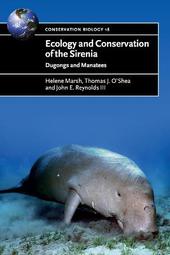
|
Ecology and Conservation of the Sirenia: Dugongs and Manatees
Paperback / softback
Main Details
| Title |
Ecology and Conservation of the Sirenia: Dugongs and Manatees
|
| Authors and Contributors |
By (author) Helene Marsh
|
|
By (author) Thomas J. O'Shea
|
|
By (author) John E. Reynolds III
|
| Series | Conservation Biology |
|---|
| Physical Properties |
| Format:Paperback / softback | | Pages:536 | | Dimensions(mm): Height 257,Width 152 |
|
| Category/Genre | Ecological science
Marine & freshwater mammals |
|---|
| ISBN/Barcode |
9780521716437
|
| Classifications | Dewey:599.557 |
|---|
| Audience | | Undergraduate | | Postgraduate, Research & Scholarly | | Professional & Vocational | |
|---|
| Illustrations |
33 Tables, black and white; 9 Plates, unspecified; 99 Halftones, unspecified; 8 Line drawings, unspecified
|
|
Publishing Details |
| Publisher |
Cambridge University Press
|
| Imprint |
Cambridge University Press
|
| Publication Date |
1 December 2011 |
| Publication Country |
United Kingdom
|
Description
Dugongs and manatees, the only fully aquatic herbivorous mammals, live in the coastal waters, rivers and lakes of more than 80 subtropical and tropical countries. Symbols of fierce conservation battles, sirenian populations are threatened by multiple global problems. Providing comparative information on all four surviving species, this book synthesises the ecological and related knowledge pertinent to understanding the biology and conservation of the sirenia. It presents detailed scientific summaries, covering sirenian feeding biology; reproduction and population dynamics; behavioural ecology; habitat requirements and threats to their continued existence. Outlining the current conservation status of the sirenian taxa, this unique study will equip researchers and professionals with the scientific knowledge required to develop proactive, precautionary and achievable strategies to conserve dugongs and manatees. Supplementary material is available online at: www.cambridge.org/9780521888288.
Author Biography
Helene Marsh is Professor of Environmental Science and Dean of Graduate Research Studies at James Cook University, Townsville, Australia. She is an international authority on the conservation biology of dugongs, sea turtles and coastal cetaceans, and led the team that developed the United Nations Environment Programme global Dugong Action Plan. Thomas J. O'Shea is Scientist Emeritus at the U.S. Geological Survey, Fort Collins, Colorado. A mammalogist, he conducted research on manatees for many years and has served on the federal Florida Manatee Recovery Team, the Committee of Scientific Advisors to the U.S. Marine Mammal Commission and the IUCN Sirenia Specialist Group. John E. Reynolds III is a Senior Scientist at Mote Marine Laboratory, Florida. He served as Chairman of the U.S. Marine Mammal Commission between 1991 and 2010 and has recently worked closely with the United Nations Environment Programme to develop and implement a Caribbean-wide Marine Mammal Action Plan.
Reviews'... this book is a synthesis and communication tool for the ongoing work of hundreds of people, from field researchers in Florida or students in Australia to villagers in Senegal.' Oryx 'This volume will be a welcome addition to any reference library and particularly is recommended for the library of all conservation-minded students interested in this unique group of mammals.' Ecology 'At last we have a scholarly guide to the literature for 'the other marine mammals', the Sirenia ... This book provides an excellent summary of what we know, what is needed and what still needs to be learned. Hopefully it will help to prevent other sirenians from following Steller's sea cow ... to extinction. The value of the book is further enhanced by online appendices containing supplementary material in extensive tables, for example on food plants eaten and parasites hosted.' Marine Biology Research 'This is an essential reference for all serious workers on sirenians, as well as marine mammalogists and biologists in general who need authoritative, detailed, current, digestible information on this group of endangered species. It will stand for years to come as the definitive textbook on sirenians.' Journal of Mammalogy 'It is clear that this volume was a labor of love, and the result of substantial feedback from colleagues across many disciplines, over many years. The result is an accessible and rich summary that is worthwhile for anyone interested in the ecological history and fate of marine mammals.' The Quarterly Review of Biology 'This volume is the most complete single scholarly source on the subject of sirenian ecology and conservation, and is likely to be so for some time. It is an essential book for all professionals engaged in sirenian conservation or research activities, and will also be a welcome addition to the libraries of other marine mammalogists ... The efforts of sirenian researchers, managers, and conservationists will be greatly aided by the wealth of knowledge and wisdom contained in this volume.' Roger Reep, Marine Mammal Science '... provides pertinent and updated data ... will be an important reference in initiating further conservation efforts.' Mammalia '... both topical and timely..this book is eminently readable ... meets a high scientific standard, is clearly written, and is well illustrated ... It is suitable for a wide audience including researchers, resource managers, and policymakers, and will also appeal to the serious graduate student with an interest in marine mammal biology, conservation and management.' Stephen Benjamins, Biological Conservation 'It is evident from the size of the tome that they have provided detail for the reader that will exceed the greatest expectations. Not surprisingly, after reading this fascinating and comprehensively clear book, I am duly impressed, as you likely will be ... this book adds to a wealth of previous works in animal conservation, behaviour, ecology, effects of human impacts, genetics and population biology. This volume will be a welcome addition to any reference library and particularly is recommended for the library of al conservation-minded students interested in this unique group of mammals.' The Ecological Society of Americas
|